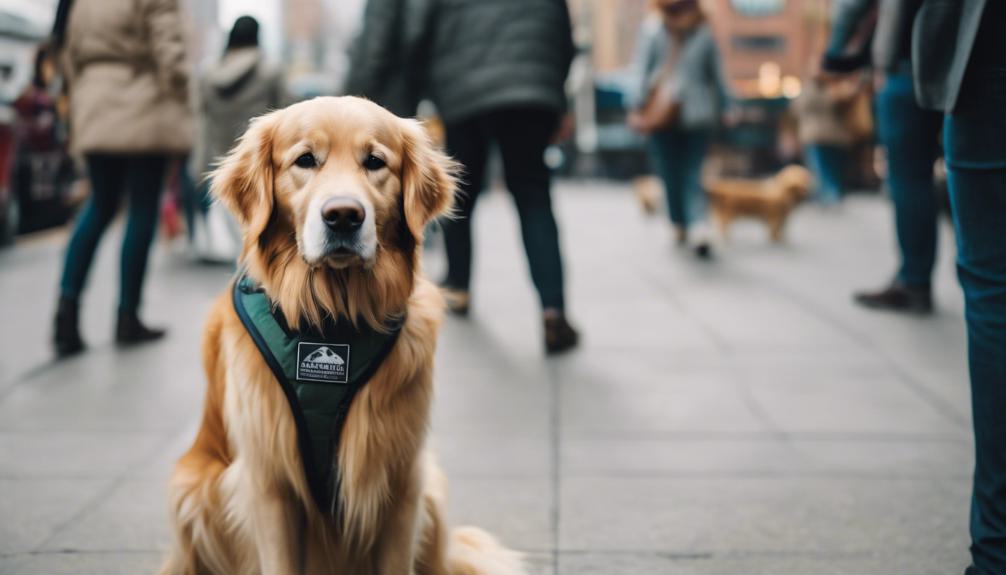How to Train Your Dog for PTSD Service? Comprehensive Guide
To train your dog for PTSD service, begin with learning basic obedience skills. Establish a strong foundation and reward positive actions. Consistency is crucial, along with creating a strong communication bond. Socialize your dog in various settings to build confidence and adaptability. Recognize signs of distress such as pacing or panting. If you notice anxiety or panic attacks, offer comfort and use distraction techniques. Designate a safe space with calming elements. Be consistent with positive reinforcement to strengthen your bond. These steps are essential for effective PTSD service dog training, providing security and assistance.
Basic Obedience Training for PTSD Dogs
For training your PTSD service dog effectively, focus first on mastering basic obedience skills like sitting, staying, and coming when called. A strong foundation in these skills is crucial. By rewarding positive actions and consistently responding to commands, your dog will learn what you expect from them. Repetition and consistency are key to making sure your dog responds reliably every time.
Through these training sessions, you build a strong communication bond with your service dog. This bond is essential for more complex tasks later on. Remember, your role as the handler is vital in teaching these basic skills for a well-trained PTSD service dog.
Now, let’s discuss the importance of consistency. Always use the same commands for tasks. For example, if you teach your dog to sit, always use the word ‘sit’ and not ‘sit down’ or ‘take a seat.’ This clarity helps your dog understand and follow your instructions better.
Before moving on to more advanced training, make sure your dog can perform basic commands in different situations. Training in various environments helps your dog adapt and perform well everywhere.
Socialization for Public Settings
To get your PTSD service dog ready for public spaces, start by exposing them to different settings, noises, and people. This socialization helps build their confidence and keeps them calm in new places. Focus on getting your dog used to loud sounds, quick movements, and various types of ground they might walk on, like tile, carpet, or pavement.
Introduce these new experiences slowly to help your dog adjust without fear. This approach ensures they stay attentive and supportive when you’re in potentially overwhelming environments such as crowded shopping centers or busy public transit systems.
Recognizing Signs of Distress

Pay close attention to your dog’s behavior changes like increased alertness or restlessness, as these can indicate distress in a PTSD service dog.
Watch for signs of stress such as pacing, panting, whining, or avoiding certain situations.
Be aware if your dog begins to show aggression or becomes overly protective.
Observe for signs of PTSD, including fear or anxiety, which might show up as trembling, hiding, or excessive licking.
Note any unusual reactions to specific triggers or situations that could upset your dog during training.
Recognizing these signs early helps you support your dog effectively in managing their distress.
Interrupting Anxiety or Panic Attacks
Service dogs trained for PTSD can interrupt anxiety or panic attacks effectively. They learn to notice when their owners show signs of distress. By providing physical comfort and emotional support, these dogs help a lot during tough times. Their training includes distraction techniques. For example, a dog might nudge or paw at its owner to help shift their focus, which can be very grounding.
These dogs play a critical role by stopping anxiety or panic attacks from getting worse. This helps their owners manage their symptoms better. By offering such support, PTSD service dogs prove to be invaluable helpers during moments of distress.
Through their special skills, these dogs offer significant assistance. They’re trained to act in specific ways that help redirect their owner’s attention during an anxiety or panic attack. This can include gentle physical interactions or creating small diversions. These actions help to calm their owner, providing immediate relief and support.
Creating a Safe Space

Creating a specific area in your home for your PTSD service dog to feel safe is essential. Use soft music and gentle commands to make this area calming. Make sure this spot is quiet and free from anything that might scare your dog. Include comfortable bedding, some toys, and items that smell familiar to help your dog relax. Teach your dog to go to this safe area when they feel stressed, and keep encouraging this behavior.
Here is a revised table to summarize the key points:
| Key Points | Actions |
|---|---|
| Set up a designated area | Choose a specific spot in your home |
| Introduce calming elements | Play soft music, use gentle commands |
| Keep the area calm | Ensure the space is quiet and undisturbed |
Remember to consistently reinforce your dog’s use of this space during stressful times. This method helps your dog know where to go when they need to calm down.
Consistency and Positive Reinforcement
To train your PTSD service dog effectively, it’s crucial to stick to a consistent routine and use positive reinforcement. Consistency lets your dog know what to expect and helps them perform better. Use positive reinforcement, like giving treats or praise, to reward good behavior and build a strong relationship with your dog.
For clear communication, set specific commands during training sessions. Try using a clicker to mark when your dog does something right, and then give them a reward to make the connection clear. Regular practice of training exercises is important to reinforce behaviors and strengthen your bond with your dog.
Frequently Asked Questions
How Do I Make My Dog a PTSD Service Dog?
To make your dog a PTSD service dog, make sure it learns to recognize and respond to your symptoms. Training involves daily living tasks and managing PTSD symptoms. Obtain a doctor’s letter and register with a service animal organization for official recognition.
Can You Train a Dog to Help With Ptsd?
You can train a dog to help with PTSD by teaching tasks that ease symptoms, like interrupting panic attacks and providing comfort. Dogs can recognize triggers, alert you to take medication, and offer safety and calmness.
Is PTSD a Disability for a Service Dog?
Yes, PTSD can be a disability for a service dog if it greatly limits your major life activities. You must have a diagnosed mental health disorder that heavily impacts your daily life to qualify for a PTSD service dog.
What Breed Makes the Best PTSD Service Dog?
When selecting a breed for a PTSD service dog, consider qualities like intelligence, trainability, and awareness of human emotions. Golden Retrievers, Labrador Retrievers, German Shepherds, and Lhasa Apsos are often recommended for their unique traits and abilities.
Conclusion
Training a dog to assist with PTSD involves several key steps. First, teach the dog basic obedience. This includes commands like sit, stay, and come. Next, focus on socializing your dog. This means exposing them to different people, places, and situations so they can react calmly in various environments. It’s also crucial to teach your dog to notice when you’re in distress.
Create a safe space for your dog at home where they can relax and feel secure. During anxiety or panic attacks, it’s important to guide your dog on how to behave to help you best.
With consistent training and a clear routine, your dog will learn how to support you effectively. Remember, training a PTSD service dog takes time and effort, but it can make a significant difference in managing your mental health.

